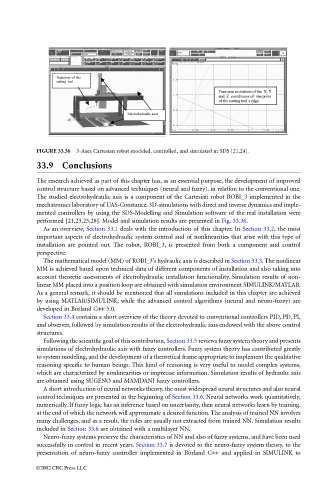Page 1001 - The Mechatronics Handbook
P. 1001
0066_frame_Ch33.fm Page 25 Wednesday, January 9, 2002 8:00 PM
FIGURE 33.36 3-Axes Cartesian robot modeled, controlled, and simulated in SDS [21,24].
33.9 Conclusions
The research achieved as part of this chapter has, as an essential purpose, the development of improved
control structure based on advanced techniques (neural and fuzzy), in relation to the conventional one.
The studied electrohydraulic axis is a component of the Cartesian robot ROBI_3 implemented in the
mechatronics laboratory of UAS-Constance. 3D-simulations with direct and inverse dynamics and imple-
mented controllers by using the SDS-Modelling and Simulation software of the real installation were
performed [21,23,25,28]. Model and simulation results are presented in Fig. 33.36.
As an overview, Section 33.1 deals with the introduction of this chapter. In Section 33.2, the most
important aspects of electrohydraulic system control and of nonlinearities that arise with this type of
installation are pointed out. The robot, ROBI_3, is presented from both a component and control
perspective.
The mathematical model (MM) of ROBI_3’s hydraulic axis is described in Section 33.3. The nonlinear
MM is achieved based upon technical data of different components of installation and also taking into
account theoretic assessments of electrohydraulic installation functionality. Simulation results of non-
linear MM placed into a position loop are obtained with simulation environment SIMULINK/MATLAB.
As a general remark, it should be mentioned that all simulations included in this chapter are achieved
by using MATLAB/SIMULINK, while the advanced control algorithms (neural and neuro-fuzzy) are
developed in Borland C++ 5.0.
Section 33.4 contains a short overview of the theory devoted to conventional controllers PID, PD, PI,
and observer, followed by simulation results of the electrohydraulic axis endowed with the above control
structures.
Following the scientific goal of this contribution, Section 33.5 reviews fuzzy system theory and presents
simulations of electrohydraulic axis with fuzzy controllers. Fuzzy system theory has contributed greatly
to system modeling, and the development of a theoretical frame appropriate to implement the qualitative
reasoning specific to human beings. This kind of reasoning is very useful to model complex systems,
which are characterized by nonlinearities or imprecise information. Simulation results of hydraulic axis
are obtained using SUGENO and MAMDANI fuzzy controllers.
A short introduction of neural networks theory, the most widespread neural structures and also neural
control techniques are presented in the beginning of Section 33.6. Neural networks work quantitatively,
numerically. If fuzzy logic has an inference based on uncertainty, then neural networks learn by training,
at the end of which the network will approximate a desired function. The analysis of trained NN involves
many challenges, and as a result, the rules are usually not extracted from trained NN. Simulation results
included in Section 33.6 are obtained with a multilayer NN.
Neuro-fuzzy systems preserve the characteristics of NN and also of fuzzy systems, and have been used
successfully in control in recent years. Section 33.7 is devoted to the neuro-fuzzy system theory, to the
presentation of neuro-fuzzy controller implemented in Borland C++ and applied in SIMULINK to
©2002 CRC Press LLC

